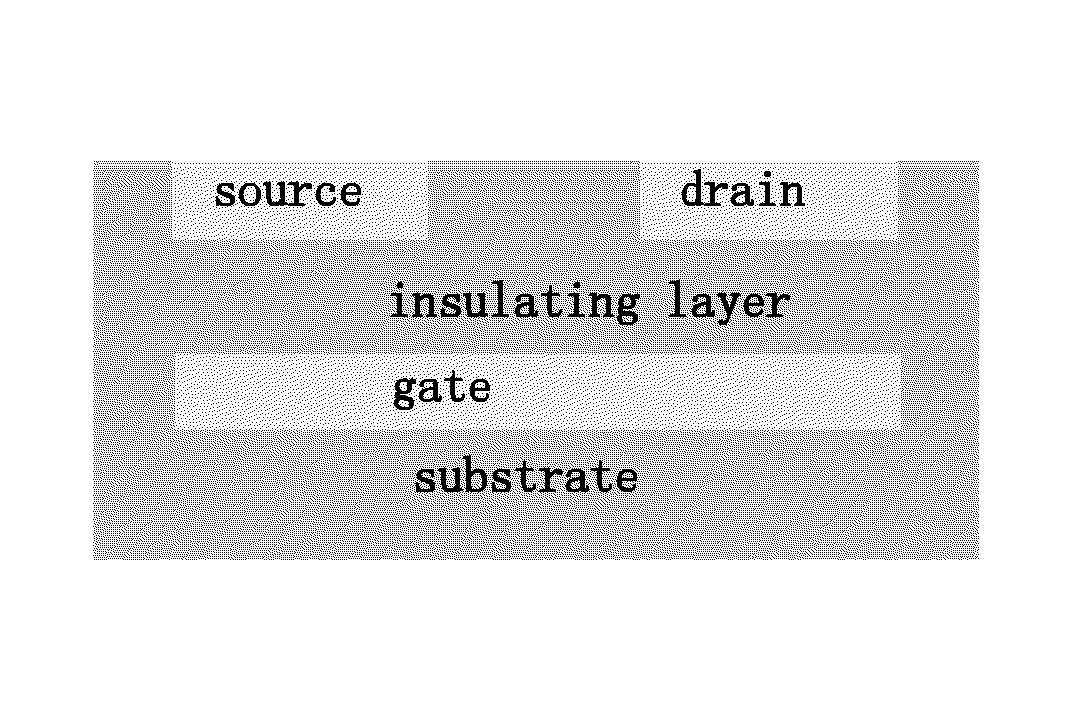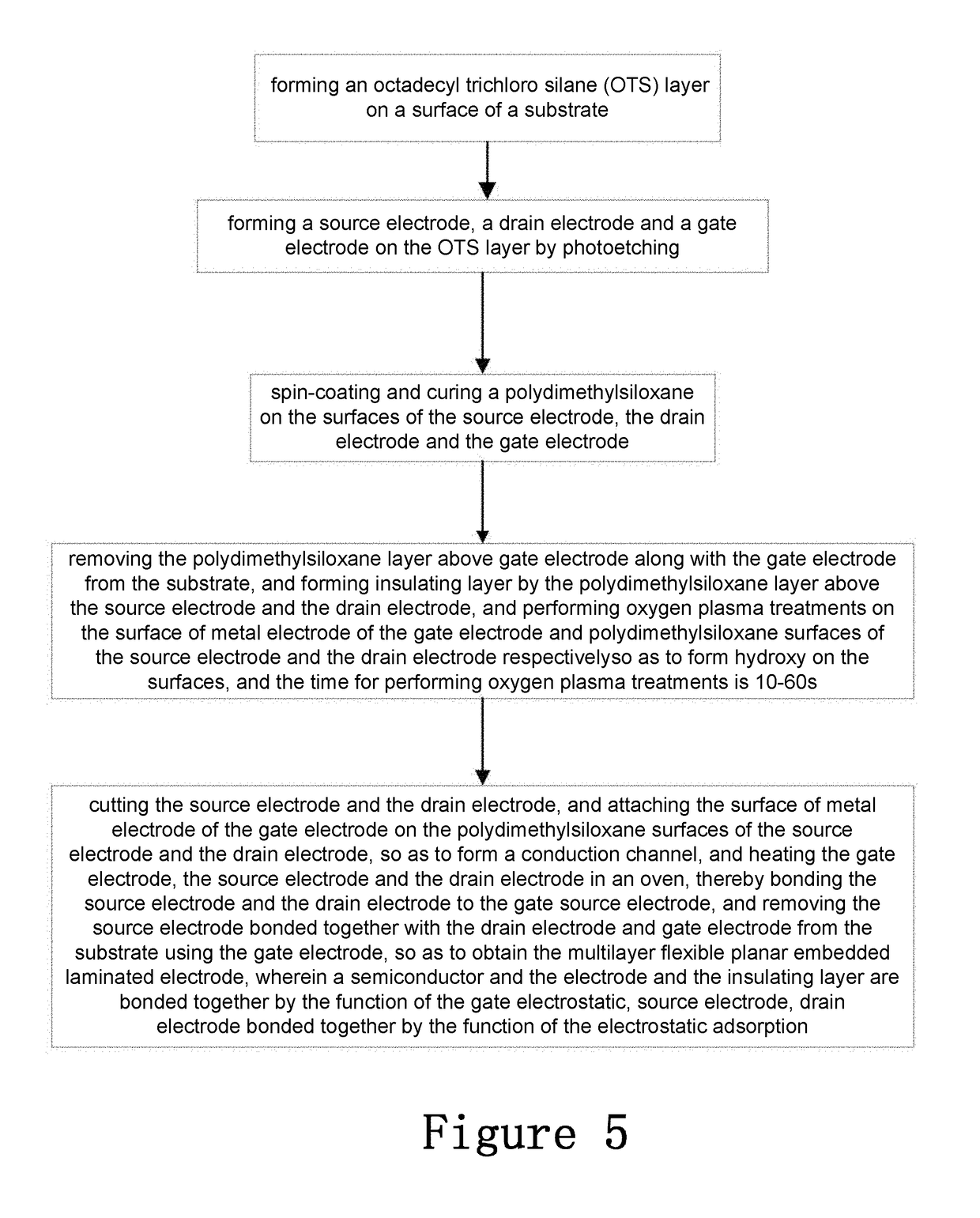Multilayer flexible planar embedded laminated electrode and manufacturing method and application thereof
a flexible, laminated electrode technology, applied in the field of organic electronic devices, can solve the problems of limiting the size of the crystal, the degree of device integration is lower, and the loss of the organic semiconductor field effect performance, etc., to achieve high integration, high precision and complex patterns, and high photolithography techniques.
- Summary
- Abstract
- Description
- Claims
- Application Information
AI Technical Summary
Benefits of technology
Problems solved by technology
Method used
Image
Examples
embodiment 1
, Manufacturing a Flexible Planar Embedded Laminated Electrode
[0044]1. A silicon surface is modified using Octadecyl trichloro silane (OTS): firstly cleaning the surface of the substrate; then placing the substrate in piranha solution (solution of concentrated sulfuric acid and hydrogen peroxide in volume ratio of 7:3), forming hydroxylation at the surface of substrate; cleaning substrate again; placing the substrate OTS solution of n-heptane in volume ratio of 1000:1, enabling the surface of substrate to form a layer of OTS.
[0045]2. A source / drain and the gate electrodes are manufactured on the OTS modified substrates using photolithography method respectively, and mercaptopropyl trimethoxysilane (MPT) may be modified at the surface of the metal surface: firstly, photoetching (baking temperature: 100 degrees; baking time: 3 minutes (min); exposure time: 20 s; developing time: 60 s; fixing time: 30 s) on the substrate using AZ5214E photoresist; and then vacuum vapor depositing a lay...
embodiment 2
, Manufacturing a Flexible Planar Embedded Laminated Electrode
[0059]1. A glass surface is modified using Octadecyl trichloro silane (OTS): firstly cleaning the surface of the substrate; then placing the substrate in piranha solution (solution of concentrated sulfuric acid and hydrogen peroxide in volume ratio of 7:3), forming hydroxylation at the surface of substrate; cleaning substrate again; placing the substrate OTS solution of n-heptane in volume ratio of 1000:1, enabling the surface of substrate to form a layer of OTS.
[0060]2. A source / drain and the gate electrodes are manufactured on the OTS modified substrates using photolithography method respectively, and mercaptopropyl trimethoxysilane (MPT) may be modified at the surface of the metal surface: firstly, photoetching (baking temperature: 100° C.; baking time: 3 minutes (min); exposure time: 20 s; developing time: 60 s; fixing time: 30 s) on the substrate using AZ5214E photoresist; and then vacuum vapor depositing a layer of ...
embodiment 3
, Manufacturing a Flexible Planar Embedded Laminated Electrode
[0068]1. A glass surface is modified using Octadecyl trichloro silane (OTS): firstly cleaning the surface of the substrate; then placing the substrate in piranha solution (solution of concentrated sulfuric acid and hydrogen peroxide in volume ratio of 7:3), forming hydroxylation at the surface of substrate; cleaning substrate again; placing the substrate OTS solution of n-heptane in volume ratio of 1000:1, enabling the surface of substrate to form a layer of OTS.
[0069]2. A source / drain and the gate electrodes are manufactured on the OTS modified substrates using photolithography method respectively, and mercaptopropyl trimethoxysilane (MPT) may be modified at the surface of the metal surface: firstly, photoetching (baking temperature: 100 degrees; baking time: 3 minutes (min); exposure time: 20 s; developing time: 60 s; fixing time: 30 s) on the substrate using AZ5214E photoresist; and then vacuum vapor depositing a layer...
PUM
 Login to View More
Login to View More Abstract
Description
Claims
Application Information
 Login to View More
Login to View More - R&D
- Intellectual Property
- Life Sciences
- Materials
- Tech Scout
- Unparalleled Data Quality
- Higher Quality Content
- 60% Fewer Hallucinations
Browse by: Latest US Patents, China's latest patents, Technical Efficacy Thesaurus, Application Domain, Technology Topic, Popular Technical Reports.
© 2025 PatSnap. All rights reserved.Legal|Privacy policy|Modern Slavery Act Transparency Statement|Sitemap|About US| Contact US: help@patsnap.com



